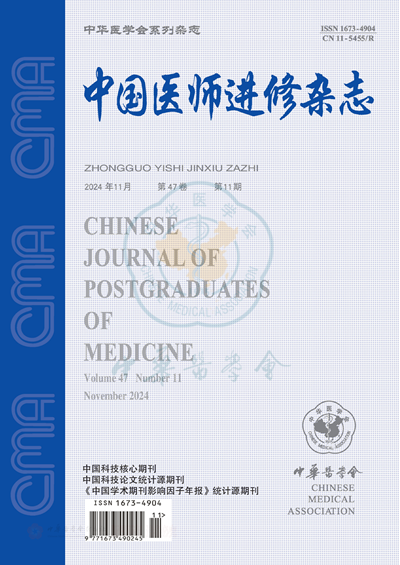Clinical analysis of early gastric carcinoma in 101 patients
引用次数: 0
Abstract
Objective To investigate the principle of lymph nodes metastasis (LNM) in early gastric carcinoma (EGC),and try to provide theoretical basis for individualized treatment. Methods One hundredand one patients were operated upon due to EGC, all clinicopathologic data were analyzed retrospectively. Results LNM was detected in 16 cases with lesion in lower stomach, the incidence of LNM was 15.8%. LNM correlated with depth of infiltration, tumor size and pathological type. The rate of LNM was 27.9% in SM2 ,significantly higher than that in M(2.8%) and SM(13.6%),P0.05.The incidence increased along with the increment of tumor size, no LNM was found in minute gastric cancer (MGC),5.0% in small gastric cancer(SGC),14.8% in patients with 1.1-2.0 cm lesion in diameter and 27.5% in greater than 2.0 cm (P0.05).Well-differentiated EGC without LNM, while the risk was 17.2%,19.6% for moderate- and poor- differentiated respectively. The research showed that, in levelⅠ tier lymph nodes (LN),the risk of No.3 LN involvement reached up to 50.0%, followed by No.6(37.5%), No.4(31.3%) and No.5(12.5%).In levelⅡ, the risk decreased gradually by 25.0%,12.5%,6.3% for No.7,8 a,9 LN respectively. In our series, M and SM1 involved level I tier LN, but levelⅡ tier LN involvement obviously increased in SM2.MGC without LNM, SGC involved level I tier LN only. Nevertheless the rate of levelⅡ tier LN involvement rose in patients with lesion greater than 1.1 cm in diameter. As the same that, no LNM in well-differentiated cancer, the risk of levelⅡ increased accompanying the worsening of differentiation. Conclusions The cognition to principle of LNM, especially the EGC in lower stomach, contribute to individualized surgery therapy and offer theoretical support for microinvasive operation.早期胃癌101例临床分析
目的探讨早期胃癌(EGC)淋巴结转移(LNM)的发生机理,为个体化治疗提供理论依据。方法对101例EGC手术患者的临床病理资料进行回顾性分析。结果16例下胃病变检出LNM, LNM的发生率为15.8%。LNM与浸润深度、肿瘤大小、病理类型相关。SM2的LNM发生率为27.9%,显著高于M(2.8%)和SM(13.6%),差异有统计学意义(P0.05)。随着肿瘤大小的增加,LNM的发生率呈上升趋势,微小胃癌(MGC)无LNM,小胃癌(SGC)为5.0%,直径1.1 ~ 2.0 cm为14.8%,大于2.0 cm为27.5% (P0.05)。高分化EGC无LNM,中度和低分化EGC的风险分别为17.2%和19.6%。研究表明,在Ⅰ级淋巴结(LN)中,3号淋巴结受累的风险高达50.0%,其次是6号淋巴结(37.5%)、4号淋巴结(31.3%)和5号淋巴结(12.5%)。在Ⅱ水平,7号、8号、9号LN的风险分别逐渐降低25.0%、12.5%、6.3%。在我们的系列中,M和SM1涉及一级LN,但在SM2中,Ⅱ级LN的参与明显增加。MGC没有LNM, SGC只涉及一级LN。然而,在病变直径大于1.1 cm的患者中,Ⅱ级LN受累率上升。同样,在分化良好的肿瘤中,无LNM,随着分化程度的加重,Ⅱ水平的风险增加。结论对LNM尤其是下胃EGC原理的认识有助于个体化手术治疗,为微创手术提供理论支持。
本文章由计算机程序翻译,如有差异,请以英文原文为准。
求助全文
约1分钟内获得全文
求助全文
来源期刊
自引率
0.00%
发文量
26239
期刊介绍:
Chinese Journal of Postgraduates of Medicine (founded in 1978, monthly) is one of the series of journals of the Chinese Medical Association (CMA) under the supervision of the National Health Commission of the People's Republic of China, sponsored by the Chinese Medical Association (CMA) and Dalian Institute of Theoretical Medicine (DITM). It is a core journal of Chinese science and technology, a statistical source journal of Chinese scientific and technical papers, and a statistical source journal of China Academic Journal Impact Factor Annual Report. The journal adheres to the purpose of using continuing medical education and post training, highlights new theories, new knowledge, new methods and new technologies, and focuses on the combination of theory and practice, and the combination of popularisation and improvement.
Main columns: Special tutorials, expert forums, clinical treatises, clinical experience, reviews and lectures, continuing medical education, teaching and research, advanced training forum, drugs and clinics, overview of progress, introduction of new technologies, imaging and clinics, lessons learnt, discussions and evaluations, case reports, discussions of clinical cases, conference proceedings, and domestic and international academic developments.
The main target readers are clinical medical personnel in internal medicine, surgery, gynaecology, paediatrics and ophthalmology.

 求助内容:
求助内容: 应助结果提醒方式:
应助结果提醒方式:


